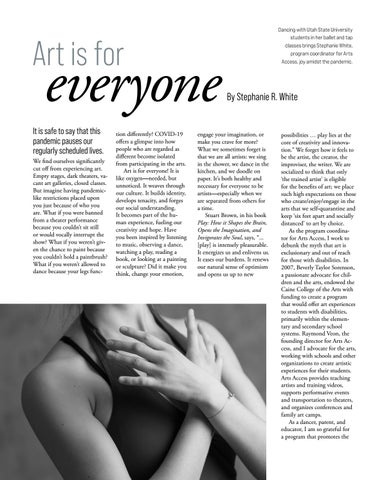Dancing with Utah State University students in her ballet and tap classes brings Stephanie White, program coordinator for Arts Access, joy amidst the pandemic.
Art is for
everyone
It is safe to say that this pandemic pauses our regularly scheduled lives. We find ourselves significantly cut off from experiencing art. Empty stages, dark theaters, vacant art galleries, closed classes. But imagine having pandemiclike restrictions placed upon you just because of who you are. What if you were banned from a theater performance because you couldn’t sit still or would vocally interrupt the show? What if you weren’t given the chance to paint because you couldn’t hold a paintbrush? What if you weren’t allowed to dance because your legs func-
46
UTAHSTATE I WINTER 2021
tion differently? COVID-19 offers a glimpse into how people who are regarded as different become isolated from participating in the arts. Art is for everyone! It is like oxygen—needed, but unnoticed. It weaves through our culture. It builds identity, develops tenacity, and forges our social understanding. It becomes part of the human experience, fueling our creativity and hope. Have you been inspired by listening to music, observing a dance, watching a play, reading a book, or looking at a painting or sculpture? Did it make you think, change your emotion,
By Stephanie R. White
engage your imagination, or make you crave for more? What we sometimes forget is that we are all artists: we sing in the shower, we dance in the kitchen, and we doodle on paper. It’s both healthy and necessary for everyone to be artists—especially when we are separated from others for a time. Stuart Brown, in his book Play: How it Shapes the Brain, Opens the Imagination, and Invigorates the Soul, says, “... [play] is intensely pleasurable. It energizes us and enlivens us. It eases our burdens. It renews our natural sense of optimism and opens us up to new
possibilities … play lies at the core of creativity and innovation.” We forget how it feels to be the artist, the creator, the improviser, the writer. We are socialized to think that only ‘the trained artist’ is eligible for the benefits of art; we place such high expectations on those who create/enjoy/engage in the arts that we self-quarantine and keep ‘six feet apart and socially distanced’ to art by choice. As the program coordinator for Arts Access, I work to debunk the myth that art is exclusionary and out of reach for those with disabilities. In 2007, Beverly Taylor Sorenson, a passionate advocate for children and the arts, endowed the Caine College of the Arts with funding to create a program that would offer art experiences to students with disabilities, primarily within the elementary and secondary school systems. Raymond Veon, the founding director for Arts Access, and I advocate for the arts, working with schools and other organizations to create artistic experiences for their students. Arts Access provides teaching artists and training videos, supports performative events and transportation to theaters, and organizes conferences and family art camps. As a dancer, parent, and educator, I am so grateful for a program that promotes the
